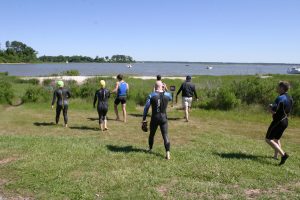 Written by Karen Kovacs, PT, OCS, USAT Level 1 Coach
Written by Karen Kovacs, PT, OCS, USAT Level 1 Coach
It’s not unusual to feel anxious about swimming in open water. Many times you have limited visibility underwater, waves and current, deep water with nowhere to rest, and your imagination starts going places you wish it wouldn’t. There are no lane lines or walls to hold and no lifeguard watching over a protected and marked area. Heart rate is increasing just thinking about getting in the water. You question why you entered the event.
As with anything, the more experience and practice you have in the open water, the less intimidating it becomes. So now is the time to start doing some short swims in open water. Start trying to identify what makes you nervous about the open water.
Acknowledging your feelings without judgment is the first step in Mindfulness training.
Shinzen Young wrote that, “mindfulness practice trains your nervous system to know itself better and interfere with itself less.”
By identifying what makes you anxious before the event, you can develop a strategy to help keep your emotions in check when those fears surface. As negative self talk creeps in, redirect your thoughts and focus on good stroke technique and finding a steady pace.
You will want to practice calming yourself down by focusing on getting into a rhythm with your breathing and stroke pattern.
It will feel like you are swimming slowly because you don’t have the visual reference of the pool walls, lane lines, or bottom tiles to give you feedback on your forward motion.
Sometimes waves can give you a feeling of vertigo. You may feel like your wetsuit is too tight or that you are getting too warm. Try to relax.
Try repeating a positive mantra: “I have trained for this swim. I am OK. I can do this. I am safe.”
Address the things that are making you uptight and go through a mental check list affirming that you are okay.
Have your goggles, cap, and wetsuit adjusted and ready for the start. Allow time for a warm up swim so that you are not surprised by the temperature or current.
Review the plan with your safety kayaker: how far away he or she will be, which side of you will the boat be, and how you will signal that you need to hold on to the boat?
It takes practice to learn how to manage the anxiety you may experience in open water swimming. Set yourself up for success by including some sessions in open water as part of your training.
Nosce te ipsum. Know thyself.
Karen Kovacs, PT, OCS is a physical therapist and clinical director of Tidewater Physical Therapy‘s Gloucester Point location. She is an accomplished endurance athlete and is a USAT Level 1 Coach.


